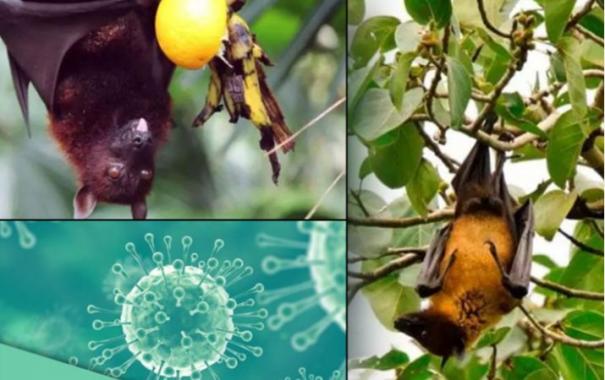Study ecological dynamics of Nipah virus: experts to govt.
Context
Experts had warned that Kerala should probably expect annual outbreaks of Nipah, though not necessarily in the same location or with the same symptom profile, given the prevalence of the Pteropus medius species of bats, found to be the key reservoirs of Nipah virus (NiV) across the State in 2019. This was true in 2019 when Nipah surfaced in the State for a second consecutive year.
What is the Nipah virus and how is it being spread?
- The Nipah virus (NiV) is a zoonotic virus that can infect both people and animals. Fruit bats, sometimes known as flying foxes, are the main vectors for its spread. Pigs and other animals can also spread it.
- NiV can spread via:
- Direct contact with infected animals or body fluids from them, such as blood, urine, or saliva
- consuming foodstuffs
- NiV can have fatal effects among other serious symptoms. Following virus exposure, symptoms usually start to manifest 4 to 14 days later. The virus can produce latent or dormant infections in some individuals. Accordingly, symptoms or death could appear months or even years after first coming into touch with the virus.
What is the Pteropus medius species of bats?
-
- The Indian subcontinent is home to the megabat species Pteropus medius, sometimes referred to as the Indian flying fox or greater Indian fruit bat. With a wingspan of 112.58 centimetres and an average body weight of 821.1 grams, it is one of the biggest bats in the world. With big, black ears and a hairy, extended nose, the Indian flying fox has a dark brown colouration. Compared to females, males are bigger.
- Distribution and Habitat: Indian flying foxes can be found in India, Bangladesh, Bhutan, Myanmar, Nepal, Pakistan, and Sri Lanka, among other nations on the Indian subcontinent. Especially in cities, close to water, and on farmland, they frequently roost in sizable colonies on tall trees. The choice of habitat is influenced by the availability of food.
- Behaviour and Ecology: These bats roost in vast, frequently thousands-strong colonies. As nocturnal animals, they go out of their roosts at night to search for ripe fruit and nectar. They hunt alone, yet when flying, they swarm together. They are known to travel far—up to 93 miles [150 km]—in quest of food.
- Diet: Indian flying foxes are largely frugivorous, which means they eat fruit as their main food source. They also consume floral nectar. They consume a broad range of fruits, and by distributing seeds through their excrement, they perform a vital part in seed dissemination. Many plant species in their range depend on them for reproduction.
- Reproduction: From July to October each year, these bats breed, and from February to May, they give birth. Usually, they give birth to one or two puppies, which the mother carries for the first few weeks. Young bats start to fly at around 11 weeks old, and weaning takes place around 5 months of age.
- Relation to people:
-
- Disease Transmission: Henipaviruses and flaviviruses, for example, have natural reservoirs in Indian flying foxes. They have been shown to have the human-transmittable Nipah virus. When doing procedures like harvesting date palm sap, where bats may contaminate the sap, there is a risk of transmission.
- Pests: Indian flying foxes are useful for spreading seeds, but because they eat ripe fruit from orchards, they are occasionally viewed as pests. They can harm crops like mangoes and guavas, but it’s important to note that overripe fruits sustain the majority of the damage.
- Use as Food and Medicine: Indian flying foxes are used as food and traditional medicine in various areas. For example, in Pakistan and India, their meat is used for medicinal purposes, and in some indigenous tribes, it is eaten as bushmeat.
How are the diseases spread through these bats?
- Date Palm Sap Contamination: Consuming raw date palm sap that has been polluted by bats is one of the most frequent ways the Nipah virus is passed from people to humans. On date palm trees, the sap has been seen flowing into collection pots, where Indian flying foxes have been seen licking the sap as it collects. Additionally, they might urinate faeces next to these pots, infecting the sap with the virus. The Nipah virus can infect people if they drink this contaminated sap without first having it properly processed.
- Defecation and Urination: Indian flying foxes have been observed to urinate and fecate when foraging in or near fruit trees. Fruit or other food items that are later consumed by people without proper cleaning or cooking if these excreta come into contact with them will cause health problems.
- Direct Contact: Although uncommon, the virus can be spread through direct contact with infected bats or their bodily fluids, such as blood or saliva. This can happen when people handle sick or dead bats without taking the necessary precautions.
What is the way forward to prevent this zoonotic disease?
- Early detection and observation
-
-
- To keep an eye on animal populations and identify potential disease outbreaks, establish and expand surveillance systems.
- Encourage cooperation between environmental, animal, and human health organizations so they may exchange information and plan responses.
-
- Observation and Research:
-
-
- Spend money on research to learn more about the dynamics of zoonotic illnesses, such as their causes, modes of transmission, and risk factors.
- To locate potential zoonotic disease reservoirs, keep an eye on the health and population of wildlife.
-
- One Health Approach:
-
-
- Adopt a “One Health” strategy that acknowledges how interrelated human, animal, and environmental health are.
- Encourage cooperation between veterinary and human health specialists to tackle zoonotic illnesses from all angles.
-
- Public Health Education:
-
-
- Inform healthcare professionals, farmers, hunters, and the general public about zoonotic illnesses.
- Give advice on the proper ways to handle animals, eat animal products, and interact with wildlife.
-
- Animal Health And Welfare:
-
-
- Promote responsible animal care methods to lessen the possibility of disease spreading from animals to people.
- Implement immunization campaigns and disease prevention strategies for populations of livestock and wildlife.
-
- Animal Protection
-
- To reduce human-wildlife encounters that can spread disease, preserve and protect natural areas.
- Put steps in place to stop the illegal wildlife trade, which can aid in the spread of zoonotic illnesses.





